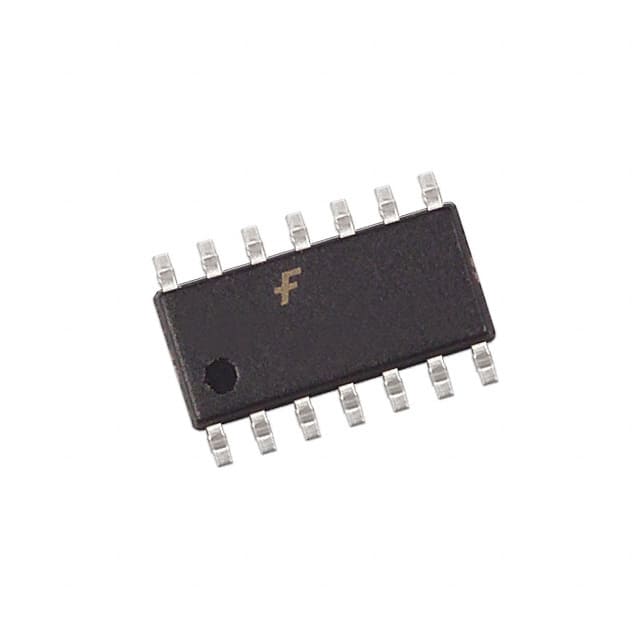Zie specificaties voor productdetails.

74F74SJ
Basic Information Overview
- Category: Integrated Circuit (IC)
- Use: Flip-Flop
- Characteristics: Dual D-Type Positive-Edge-Triggered Flip-Flop
- Package: SOIC (Small Outline Integrated Circuit)
- Essence: Sequential Logic Device
- Packaging/Quantity: Tape and Reel, 2500 units per reel
Specifications
- Supply Voltage Range: 4.5V to 5.5V
- High-Level Input Voltage: 2V to VCC + 0.5V
- Low-Level Input Voltage: -0.5V to 0.8V
- High-Level Output Voltage: VCC - 0.5V
- Low-Level Output Voltage: 0.5V
- Maximum Operating Frequency: 100MHz
Detailed Pin Configuration
The 74F74SJ IC has a total of 14 pins. The pin configuration is as follows:
- CLR (Clear) - Active LOW input for resetting the flip-flop.
- D1 (Data Input 1) - Data input for the first flip-flop.
- CLK (Clock) - Clock input for triggering the flip-flop.
- D2 (Data Input 2) - Data input for the second flip-flop.
- Q1 (Output 1) - Output of the first flip-flop.
- Q1' (Complementary Output 1) - Complementary output of the first flip-flop.
- GND (Ground) - Ground reference voltage.
- Q2' (Complementary Output 2) - Complementary output of the second flip-flop.
- Q2 (Output 2) - Output of the second flip-flop.
- PRE (Preset) - Active LOW input for setting the flip-flop.
- VCC (Supply Voltage) - Positive supply voltage.
- NC (No Connection) - No electrical connection.
- NC (No Connection) - No electrical connection.
- NC (No Connection) - No electrical connection.
Functional Features
- Dual D-Type Flip-Flop: The 74F74SJ contains two independent D-type flip-flops in a single IC package.
- Positive-Edge Triggered: The flip-flops are triggered on the rising edge of the clock signal.
- Asynchronous Clear and Preset Inputs: The flip-flops can be asynchronously cleared or preset using the CLR and PRE inputs, respectively.
- Complementary Outputs: Each flip-flop has both an output (Q) and its complementary output (Q').
Advantages and Disadvantages
Advantages: - Compact Design: The integration of two flip-flops in a single IC package saves board space. - High-Speed Operation: The 74F74SJ operates at a maximum frequency of 100MHz, making it suitable for high-speed applications. - Versatile: The asynchronous clear and preset inputs provide flexibility in controlling the flip-flop's state.
Disadvantages: - Limited Functionality: The 74F74SJ is specifically designed as a dual D-type flip-flop and may not be suitable for more complex sequential logic applications. - Power Consumption: Like most integrated circuits, the 74F74SJ consumes power during operation.
Working Principles
The 74F74SJ is based on the principles of sequential logic. It utilizes positive-edge triggering to capture and store data at the input (D) when a clock pulse is received. The stored data is then available at the outputs (Q and Q') until the next clock pulse arrives. The flip-flops can be asynchronously cleared or preset using the CLR and PRE inputs, respectively, allowing for controlled initialization of the stored data.
Detailed Application Field Plans
The 74F74SJ is commonly used in various digital systems and applications, including: - Counters and Registers: The flip-flops can be cascaded to create larger counters or registers for data storage and manipulation. - State Machines: The sequential nature of the flip-flops makes them suitable for implementing state machines, such as finite state controllers. - Clock Synchronization: The positive-edge triggering ensures synchronized operation with other components in a digital system.
Detailed and Complete Alternative Models
- 74LS74: Similar dual D-type flip-flop with TTL (Transistor-Transistor Logic) compatibility.
- CD4013: Dual D-type flip-flop with CMOS (Complementary Metal-Oxide-Semiconductor) technology.
- SN74HC74: Dual D-type flip-flop with high-speed CMOS logic.
Note: The above alternative models are just a few examples, and there are several other similar ICs available in the market.
This entry provides an overview of the 74F74SJ, a dual D-type positive-edge-triggered flip-flop integrated circuit. It includes information on its basic
Noem 10 veelgestelde vragen en antwoorden met betrekking tot de toepassing van 74F74SJ in technische oplossingen
Sure! Here are 10 common questions and answers related to the application of 74F74SJ in technical solutions:
Q: What is the 74F74SJ? A: The 74F74SJ is a dual D-type flip-flop integrated circuit (IC) that can store one bit of data.
Q: What is the purpose of using the 74F74SJ in technical solutions? A: The 74F74SJ is commonly used for sequential logic applications, such as storing and manipulating binary data.
Q: How many flip-flops are there in the 74F74SJ IC? A: The 74F74SJ contains two independent D-type flip-flops.
Q: What is the maximum clock frequency supported by the 74F74SJ? A: The 74F74SJ typically supports clock frequencies up to 100 MHz.
Q: Can the 74F74SJ be used for edge-triggered or level-triggered operations? A: Yes, the 74F74SJ can be configured for both edge-triggered and level-triggered operations.
Q: What is the power supply voltage range for the 74F74SJ? A: The 74F74SJ typically operates with a power supply voltage range of 4.5V to 5.5V.
Q: Does the 74F74SJ have any built-in asynchronous inputs? A: Yes, the 74F74SJ has asynchronous preset (PRE) and clear (CLR) inputs for immediate state changes.
Q: Can I cascade multiple 74F74SJ ICs together? A: Yes, you can cascade multiple 74F74SJ ICs to create larger storage registers or counters.
Q: What is the typical propagation delay of the 74F74SJ? A: The typical propagation delay of the 74F74SJ is around 10 ns.
Q: Are there any special considerations for using the 74F74SJ in high-speed applications? A: Yes, in high-speed applications, it is important to consider signal integrity, noise immunity, and proper decoupling to ensure reliable operation.
Please note that the specific details and characteristics of the 74F74SJ may vary, so it's always recommended to refer to the datasheet provided by the manufacturer for accurate information.

